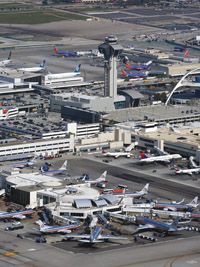Special Report: Security
Wasting money?
A new academic research paper argues that global airports could be over-investing in services aimed at preventing terror attacks.
June 1st 2014
As the cost of aviation security has ballooned to US$8.55 billion annually since the terror attacks on the U.S. on September 11, 2001, a recently published research paper said costs and benefits need to be assessed before airports add more layers of security at their facilities. Read More »
The academic research argues that additional security measures to protect airports are not “sensible expenditures” as statistics show the likelihood of an attack on airport is low.
 |
| Number of attacks on airports doesn’t justify the cost of security |
“Cost-benefit Analysis of Airport Security: Are airports too safe?”, written by John Mueller, a professor of political science and a security studies expert at Ohio State University and Mark G. Stewart, a professor of civil engineering at Australia’s University of Newcastle, argue that additional security measures to protect airports are not “sensible expenditures” as statistics show the likelihood of an attack on airport is low.
Published in March in the Journal of Air Transport Management, the two academics said they assessed the risks and cost-effectiveness of security measures designed to protect airport terminals and associated facilities, such as car parks, in the Asia-Pacific, Europe and the U.S.
As a result, they argue that relaxing security measures already in place at airports may make sense because the number of attacks on airports doesn’t justify the cost of security. While airports can be attractive targets for terrorists, they are less so than other busy public locations because people are more spread out over an airport complex, they assert.
“Compared with many other places of congregation, people are more dispersed in airports. Therefore, a terrorist attack is likely to kill far fewer people for example than targeting a crowded stadium,” they said.
“In fact, it may be worthwhile to consider whether airports are actually very attractive terrorist targets. If the goal of the terrorist is to kill people and inflict physical damage, there are many other places to detonate a bomb or undertake an armed attack” that would be more damaging, the research argues.
The authors said Los Angeles International Airport is an example of a facility that has the option of building more security measures into its facilities. Among them are permanent vehicle search checkpoints with bomb detection capability, more Transport Security Agency (TSA) lines, enhanced training of airport police rapid reaction teams to SWAT standards, eliminating traffic lanes closest to the airport’s terminals and other changes.
If big airports, including Asia-Pacific airports, carried out similar security enhancements, the cost could be as high as US$124 billion.
Between 1998 and 2011, the Global Terrorism Database recorded 20 attacks on airports in the U.S. and Europe, which killed 64 people. Over the same period, there were 31 attacks on aircraft, making the total number of attacks on aviation only 0.5% of all terrorist attacks over the 13-year period.
“This experience has led the 2007 U.S. National Strategy for Aviation Security to conclude that ‘reported threats to aviation infrastructure, including airports and air navigation facilities, are relatively few,’ the academics wrote.
Stewart and Mueller examined 53 cases since the 9/11 terrorist attacks on the U.S. in which Muslim terrorists planned, or “vaguely imagined, doing damage in the U.S.”. They found there were only two planned attacks on an airport facility.
Despite these findings, a majority of the literature on homeland security “dwells on vulnerabilities and recommends enhanced security measures with little or no attention paid to how much security measures will actually cost”, said Mueller and Stewart.
In comparison, the 9/11 attacks killed almost 3,000 people, with associated losses of $20 billion. Additionally, 9/11 caused “approximately $30 billion in physical damage”, [and] had an impact on the U.S. economy of $50 billion to $150 billion.
Global airline losses from the 9/11 attacks were at least $100 billion. However, these losses were mainly due to a drop in airline passengers in 2001 and 2002 and the “next attack is unlikely to cause the same response”, the authors said.
They said the “assessed security measures would only begin to be cost-effective if the current rate of attacks at airports in the U. S., Europe and the Asia-Pacific increases by a factor of 10 to 20”.
“Moreover, if the analysis suggests that enhancement of airport security is highly questionable, it may well be time to consider if many of the security arrangements already in place to protect airports are excessive,” the authors concluded.